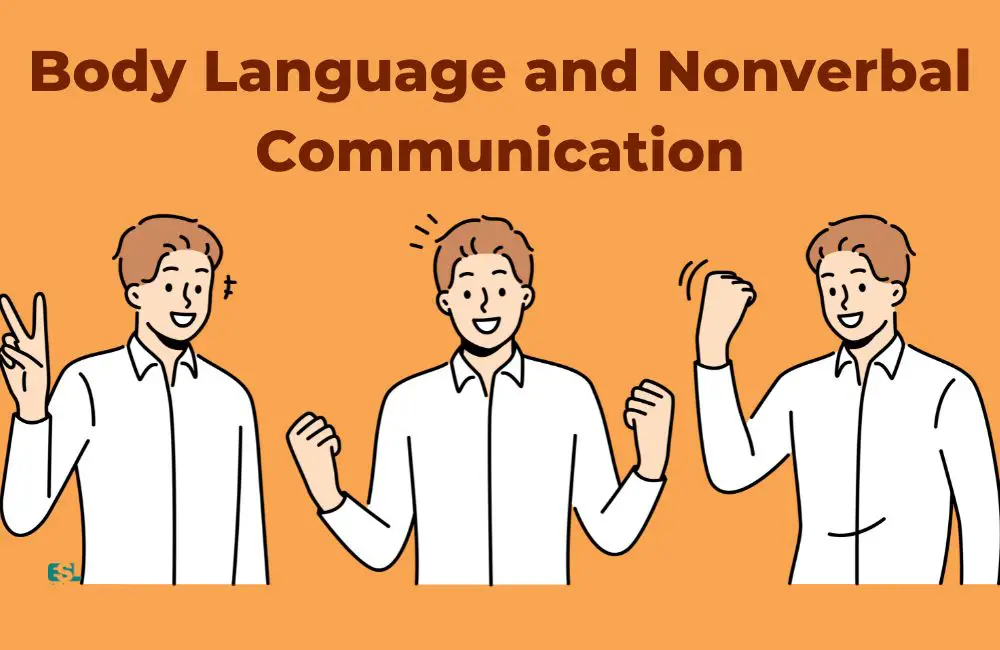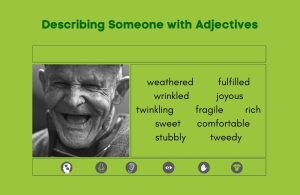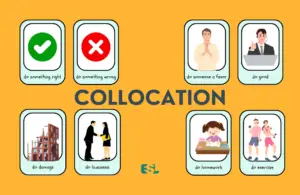Effective communication goes beyond spoken or written words. It involves a complex mix of facial expressions, body posture, gestures, tone of voice, and even our silences. This article provides a comprehensive guide to the terminology associated with body language and nonverbal communication.
Whether you’re a psychology student, an aspiring actor, a novelist keen on crafting lifelike characters, or simply a curious individual, these words will help you accurately describe and interpret the nonverbal cues we encounter in daily life.
The Dictionary of Body Language (Amazon Link) is a body language bible for anyone looking to understand what their boss really means, interpret whether a potential romantic partner is interested or not, and learn how to put themselves forward in the most favorable light. I recommend this book to all my students who want to develop their non verbal communication skills.
Table of Contents
- 1. Facial Expressions
- 2. Eye Movements and Gaze
- 3. Posture and Movement
- 4. Touch
- 5. Voice and Tone
- Sample Conversation: Using Vocabulary Related to Body Language and Nonverbal Communication
- Conclusion
- FAQ: Vocabulary Related to Body Language and Nonverbal Communication
1. Facial Expressions
Facial expressions often communicate our emotions more accurately than our words. They’re typically involuntary and universal across cultures.
| Word/Phrase | Meaning/Usage | Example Sentences |
|---|---|---|
| Frown | A facial expression showing displeasure, usually characterized by a furrowing of one’s brows | “John’s frown indicated that he disagreed with the plan.” |
| Grin | A wide smile, often expressing joy or amusement | “Sarah’s grin made it clear she was enjoying the party.” |
| Grimace | An expression of discomfort or pain | “He grimaced as he touched his injured arm.” |
| Sneer | A scornful or mocking smile | “The bully sneered at the new kid’s outfit.” |
| Scowl | A facial expression of dislike or anger, characterized by a furrowing of the eyebrows | “Her scowl was enough to make anyone step back.” |
| Beam | A radiant or good-natured look or smile | “He beamed at his daughter’s achievement.” |
| Smirk | A smug, conceited, or silly smile | “She smirked when she realized she had won.” |
| Gape | Open the mouth wide in surprise or wonder | “They gaped at the stunning fireworks display.” |
| Flinch | Make a quick, nervous movement as an instinctive reaction to fear or pain | “He flinched when the doctor prepared the injection.” |
| Wince | Give a slight involuntary grimace or shrinking movement due to discomfort or pain | “She winced as she removed the band-aid.” |
2. Eye Movements and Gaze
Our eyes can convey a wealth of information. From showing interest to expressing emotions, eye movements and gaze are powerful nonverbal communication tools.
| Word/Phrase | Meaning/Usage | Example Sentences |
|---|---|---|
| Eye Contact | When two people look directly into each other’s eyes | “Maintaining good eye contact during a conversation can demonstrate confidence.” |
| Glare | An angry or fierce stare | “The teacher glared at the disruptive student.” |
| Squint | Narrow one’s eyes slightly so as to see better | “He squinted to read the small print on the label.” |
| Blink Rate | The frequency with which someone blinks, often indicative of emotional state or cognitive effort | “Nervous individuals often have an increased blink rate.” |
| Stare | Look fixedly or vacantly at someone or something | “He stared at the painting, trying to understand its meaning.” |
| Wink | Close and open one eye quickly, typically to indicate that something is a joke or a secret | “He winked at me, letting me know he was joking.” |
| Glance | A brief or hurried look | “She glanced at her watch, realizing she was late.” |
| Gaze | Look steadily and intently, especially in admiration, surprise, or thought | “He gazed out the window at the snow-covered landscape.” |
| Eye Rolling | The act of rolling one’s eyes, usually indicating annoyance or disbelief | “She rolled her eyes at his terrible joke.” |
| Peer | Look with difficulty or concentration at someone or something | “He peered into the darkness, trying to identify the strange noise.” |
If you are searching for an effective English language vocabulary builder, try Word Power Made Easy: The Complete Handbook for Building a Superior Vocabulary (Amazon Link). This time-tested classic has helped millions achieve mastery of English and improve their communication skills in business, the classroom, and in life.
3. Posture and Movement
How we hold our bodies and move can communicate a great deal about our attitudes, level of confidence, and current mood.
| Word/Phrase | Meaning/Usage | Example Sentences |
|---|---|---|
| Slouch | Stand, move, or sit in a lazy, drooping way | “Don’t slouch in your chair – it’s bad for your back.” |
| Stand Erect | Stand up straight | “She stood erect, exuding confidence and authority.” |
| Fidget | Make small movements, especially of the hands and feet, through nervousness or impatience | “He began to fidget, a clear sign of his nervousness.” |
| Swagger | Walk or behave in a very confident and typically arrogant or aggressive way | “He swaggered into the room, full of self-importance.” |
| Shrug | Raise one’s shoulders slightly and momentarily to express doubt, ignorance, or indifference | “When asked about the incident, he just shrugged.” |
| Gesticulate | Use gestures, especially dramatic ones, instead of speaking or to emphasize one’s words | “She was gesticulating wildly during her animated conversation.” |
| Slump | Sit, lean, or fall heavily and limply | “After a long day, he slumped onto the couch.” |
| Lean | Incline or bend from a vertical position | “She leaned against the wall, listening to the music.” |
| Stoop | Bend one’s head or body forward and downward | “He stooped to pick up the pen.” |
| Pace | Walk at a steady speed, especially back and forth and as an expression of one’s anxiety or annoyance | “He paced the room, waiting for the call.” |
4. Touch
Touch, or tactile communication, can convey numerous emotions between people, such as comfort, love, and empathy.
| Word/Phrase | Meaning/Usage | Example Sentences |
|---|---|---|
| Pat | Touch quickly and gently with the flat of the hand | “She patted the dog’s head affectionately.” |
| Stroke | Move one’s hand with gentle pressure over (a surface, especially hair, fur, or skin), typically repeatedly | “He stroked his beard thoughtfully.” |
| Handshake | A traditional greeting or expression of agreement in which two people grasp each other’s right hands and move them up and down | “A firm handshake can leave a positive impression.” |
| Hug | Hold (someone) closely in one’s arms, typically as a sign of affection | “She gave her friend a comforting hug.” |
| Hold hands | When two people hold each other’s hands | “The couple held hands as they walked along the beach.” |
| Slap | Hit or strike with the palm of the hand or a flat object | “He slapped the mosquito on his arm.” |
| Pinch | Grasp (something) tightly and sharply between finger and thumb | “She pinched her nose to avoid the unpleasant smell.” |
| Squeeze | Firmly press (something soft or yielding), typically with one’s fingers | “She squeezed his hand reassuringly.” |
| Punch | Strike with the fist | “He was so angry that he punched the wall.” |
| Tap | Strike (something) lightly, typically with a metal object | “He tapped his fingers on the desk, impatiently waiting for the meeting to start.” |
5. Voice and Tone
Our voice tone, pitch, volume, and speed of speech are also part of nonverbal communication, adding context to our words.
| Word/Phrase | Meaning/Usage | Example Sentences |
|---|---|---|
| Whisper | Speak very softly using one’s breath rather than one’s throat, especially for the sake of privacy | “He whispered the secret in her ear.” |
| Shout | Say something very loudly | “She had to shout to be heard over the noise.” |
| Mumble | Say something indistinctly and quietly, making it difficult for others to hear | “He mumbled something under his breath.” |
| Sigh | Emit a long, deep audible breath expressing sadness, relief, tiredness, or similar | “She sighed with relief when she heard the good news.” |
| Giggle | Laugh lightly and repeatedly in a silly way, from amusement, nervousness, or embarrassment | “They giggled at the awkward comment.” |
| Groan | Make a deep inarticulate sound in response to pain or despair | “He groaned when he saw the amount of work left to do.” |
| Stutter | Talk with continued involuntary repetition of sounds, especially initial consonants | “He had a slight stutter which became more pronounced when he was nervous.” |
| Exclaim | Cry out suddenly, especially in surprise, anger, or pain | “She exclaimed in delight when she saw the surprise.” |
| Grunt | A low, guttural sound made by an animal or a person | “He grunted in acknowledgment when his name was called.” |
| Roar | Utter a full, deep, prolonged cry, typically in pain or anger | “He roared with laughter at the joke.” |
To elevate your vocabulary in just 30 days, I recommend to my students an informative, fun, and accessible guide to utilizing powerful language. Millions of individuals have enhanced their academics, job skills, and confidence by dedicating just fifteen minutes daily to the exercises and tests of 30 Days to a More Powerful Vocabulary (Amazon Link), a top-selling. It offers step-by-step methods to bolster language prowess, discover compelling words, and daily vocabulary enhancement with pronunciation guidance.
Sample Conversation: Using Vocabulary Related to Body Language and Nonverbal Communication
Situation: In a park, Sarah, a psychologist, and Chris, a theater director, discuss the significance of body language in conveying emotions and intentions.
Sarah: Chris, I’ve always believed that nonverbal cues play a critical role in communication. It’s fascinating how an eyebrow raise or a simple shoulder shrug can convey so much.
Chris: Absolutely, Sarah. In theater, actors heavily rely on gestures and facial expressions to bring their characters to life. A fidget or a prolonged gaze can tell a story without words.
Sarah: Indeed. In psychology, we often study posture and stance to understand a person’s confidence level or state of mind. For instance, someone who crosses their arms might be defensive or closed off.
Chris: That’s insightful. When directing, I emphasize the importance of proxemics – the use of space. How close or far an actor stands from another can signify intimacy, aggression, or indifference.
Sarah: And don’t get me started on tone of voice. It’s not just what you say, but how you say it that matters. A soft whisper can be more impactful than a shout.
Conclusion
Understanding nonverbal communication and body language is a vital skill in human interaction. Whether interpreting the silent messages sent by facial expressions or becoming more aware of our nonverbal cues, a comprehensive understanding of this field can significantly improve our ability to communicate effectively.
This list of terms is just the beginning – as with any language, fluency comes from practice and observation. So, watch, learn, and communicate.
FAQ: Vocabulary Related to Body Language and Nonverbal Communication
1. What are nonverbal cues?
Nonverbal cues are signals or behaviors, other than spoken words, that communicate messages and emotions. They include facial expressions, gestures, posture, and tone of voice.
2. How do gestures differ from facial expressions?
Gestures are movements made with the body, especially hands and arms, to convey an idea or emotion. In contrast, facial expressions involve movements and configurations of the face to show feelings.
3. Why is posture significant in communication?
Posture, or the way one stands or sits, can convey confidence, attentiveness, or even disinterest. It provides insight into a person’s feelings and attitudes.
4. What does it mean when someone crosses their arms?
When someone crosses their arms, it can indicate defensiveness, discomfort, or a closed-off attitude. However, context is essential, as it might also signify coldness or just a comfortable resting position.
5. How does proxemics impact communication?
Proxemics refers to the use and perception of one’s personal and interpersonal space. The distance between communicators can indicate levels of intimacy, comfort, or dominance.
6. Why is tone of voice crucial in understanding messages?
Tone of voice adds an emotional layer to spoken words. It can change the meaning of a statement, indicating sarcasm, sincerity, anger, or affection.
7. What does a prolonged gaze convey?
A prolonged gaze or extended eye contact can signify various emotions, including interest, attraction, challenge, or even hostility, depending on the context.
8. How does fidgeting affect perception in communication?
Fidgeting, or making small movements due to nervousness or impatience, can convey discomfort, anxiety, or restlessness.
9. What role does a whisper play in communication?
A whisper, or soft-spoken voice, can imply secrecy, intimacy, or a need for discretion. It can also convey urgency or caution in certain situations.
10. Are all nonverbal cues universally understood?
No, cultural differences can influence the interpretation of nonverbal cues. What’s considered polite or rude in one culture might be perceived differently in another.






